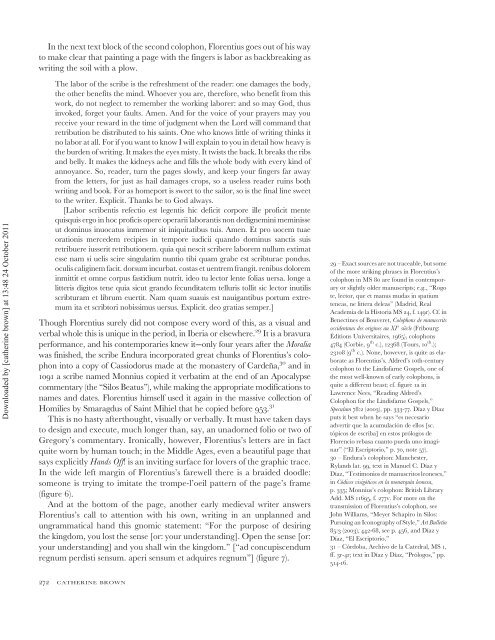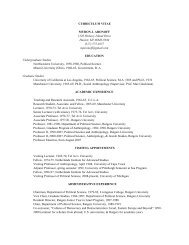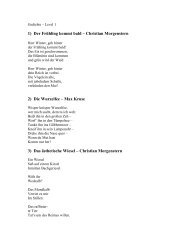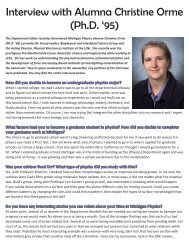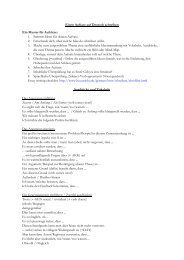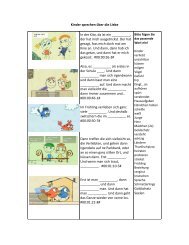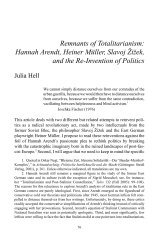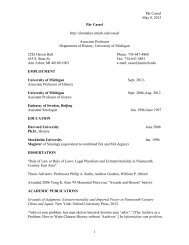Remember the Hand: Bodies and Bookmaking in Early Medieval ...
Remember the Hand: Bodies and Bookmaking in Early Medieval ...
Remember the Hand: Bodies and Bookmaking in Early Medieval ...
You also want an ePaper? Increase the reach of your titles
YUMPU automatically turns print PDFs into web optimized ePapers that Google loves.
Downloaded by [ca<strong>the</strong>r<strong>in</strong>e brown] at 13:48 24 October 2011<br />
In <strong>the</strong> next text block of <strong>the</strong> second colophon, Florentius goes out of his way<br />
to make clear that pa<strong>in</strong>t<strong>in</strong>g a page with <strong>the</strong> f<strong>in</strong>gers is labor as backbreak<strong>in</strong>g as<br />
writ<strong>in</strong>g <strong>the</strong> soil with a plow.<br />
The labor of <strong>the</strong> scribe is <strong>the</strong> refreshment of <strong>the</strong> reader: one damages <strong>the</strong> body,<br />
<strong>the</strong> o<strong>the</strong>r benefits <strong>the</strong> m<strong>in</strong>d. Whoever you are, <strong>the</strong>refore, who benefit from this<br />
work, do not neglect to remember <strong>the</strong> work<strong>in</strong>g laborer: <strong>and</strong> so may God, thus<br />
<strong>in</strong>voked, forget your faults. Amen. And for <strong>the</strong> voice of your prayers may you<br />
receive your reward <strong>in</strong> <strong>the</strong> time of judgment when <strong>the</strong> Lord will comm<strong>and</strong> that<br />
retribution be distributed to his sa<strong>in</strong>ts. One who knows little of writ<strong>in</strong>g th<strong>in</strong>ks it<br />
no labor at all. For if you want to know I will expla<strong>in</strong> to you <strong>in</strong> detail how heavy is<br />
<strong>the</strong> burden of writ<strong>in</strong>g. It makes <strong>the</strong> eyes misty. It twists <strong>the</strong> back. It breaks <strong>the</strong> ribs<br />
<strong>and</strong> belly. It makes <strong>the</strong> kidneys ache <strong>and</strong> fills <strong>the</strong> whole body with every k<strong>in</strong>d of<br />
annoyance. So, reader, turn <strong>the</strong> pages slowly, <strong>and</strong> keep your f<strong>in</strong>gers far away<br />
from <strong>the</strong> letters, for just as hail damages crops, so a useless reader ru<strong>in</strong>s both<br />
writ<strong>in</strong>g <strong>and</strong> book. For as homeport is sweet to <strong>the</strong> sailor, so is <strong>the</strong> f<strong>in</strong>al l<strong>in</strong>e sweet<br />
to <strong>the</strong> writer. Explicit. Thanks be to God always.<br />
[Labor scribentis refectio est legentis hic deficit corpore ille proficit mente<br />
quisquis ergo <strong>in</strong> hoc proficis opere operarii laborantis non dedignem<strong>in</strong>i mem<strong>in</strong>isse<br />
ut dom<strong>in</strong>us <strong>in</strong>uocatus <strong>in</strong>memor sit <strong>in</strong>iquitatibus tuis. Amen. Et pro uocem tuae<br />
orationis mercedem recipies <strong>in</strong> tempore iudicii qu<strong>and</strong>o dom<strong>in</strong>us sanctis suis<br />
retribuere iusserit retributionem. quia qui nescit scribere laborem nullum extimat<br />
esse nam si uelis scire s<strong>in</strong>gulatim nuntio tibi quam grabe est scribturae pondus.<br />
oculis calig<strong>in</strong>em facit. dorsum <strong>in</strong>curbat. costas et uentrem frangit. renibus dolorem<br />
<strong>in</strong>mittit et omne corpus fastidium nutrit. ideo tu lector lente folias uersa. longe a<br />
litteris digitos tene quia sicut gr<strong>and</strong>o fecunditatem telluris tollit sic lector <strong>in</strong>utilis<br />
scribturam et librum euertit. Nam quam suauis est nauigantibus portum extremum<br />
ita et scribtori nobissimus uersus. Explicit. deo gratias semper.]<br />
Though Florentius surely did not compose every word of this, as a visual <strong>and</strong><br />
verbal whole this is unique <strong>in</strong> <strong>the</strong> period, <strong>in</strong> Iberia or elsewhere. 29 It is a bravura<br />
performance, <strong>and</strong> his contemporaries knew it---only four years after <strong>the</strong> Moralia<br />
was f<strong>in</strong>ished, <strong>the</strong> scribe Endura <strong>in</strong>corporated great chunks of Florentius’s colophon<br />
<strong>in</strong>to a copy of Cassiodorus made at <strong>the</strong> monastery of Cardeña, 30 <strong>and</strong> <strong>in</strong><br />
1091 a scribe named Monnius copied it verbatim at <strong>the</strong> end of an Apocalypse<br />
commentary (<strong>the</strong> ‘‘Silos Beatus’’), while mak<strong>in</strong>g <strong>the</strong> appropriate modifications to<br />
names <strong>and</strong> dates. Florentius himself used it aga<strong>in</strong> <strong>in</strong> <strong>the</strong> massive collection of<br />
Homilies by Smaragdus of Sa<strong>in</strong>t Mihiel that he copied before 953. 31<br />
This is no hasty afterthought, visually or verbally. It must have taken days<br />
to design <strong>and</strong> execute, much longer than, say, an unadorned folio or two of<br />
Gregory’s commentary. Ironically, however, Florentius’s letters are <strong>in</strong> fact<br />
quite worn by human touch; <strong>in</strong> <strong>the</strong> Middle Ages, even a beautiful page that<br />
says explicitly <strong>H<strong>and</strong></strong>s Off! is an <strong>in</strong>vit<strong>in</strong>g surface for lovers of <strong>the</strong> graphic trace.<br />
In <strong>the</strong> wide left marg<strong>in</strong> of Florentius’s farewell <strong>the</strong>re is a braided doodle:<br />
someone is try<strong>in</strong>g to imitate <strong>the</strong> trompe-l’oeil pattern of <strong>the</strong> page’s frame<br />
(figure 6).<br />
And at <strong>the</strong> bottom of <strong>the</strong> page, ano<strong>the</strong>r early medieval writer answers<br />
Florentius’s call to attention with his own, writ<strong>in</strong>g <strong>in</strong> an unplanned <strong>and</strong><br />
ungrammatical h<strong>and</strong> this gnomic statement: ‘‘For <strong>the</strong> purpose of desir<strong>in</strong>g<br />
<strong>the</strong> k<strong>in</strong>gdom, you lost <strong>the</strong> sense [or: your underst<strong>and</strong><strong>in</strong>g]. Open <strong>the</strong> sense [or:<br />
your underst<strong>and</strong><strong>in</strong>g] <strong>and</strong> you shall w<strong>in</strong> <strong>the</strong> k<strong>in</strong>gdom.’’ [‘‘ad concupiscendum<br />
regnum perdisti sensum. aperi sensum et adquires regnum’’] (figure 7).<br />
272 CATHERINE BROWN<br />
29 – Exact sources are not traceable, but some<br />
of <strong>the</strong> more strik<strong>in</strong>g phrases <strong>in</strong> Florentius’s<br />
colophon <strong>in</strong> MS 80 are found <strong>in</strong> contemporary<br />
or slightly older manuscripts; e.g., ‘‘Rogo<br />
te, lector, que et manus mudas <strong>in</strong> spatium<br />
teneas, ne littera deleas’’ (Madrid, Real<br />
Academia de la Historia MS 24, f. 149r). Cf. <strong>in</strong><br />
Benect<strong>in</strong>es of Bouveret, Colophons de manuscrits<br />
occidentaux des orig<strong>in</strong>es au XI e siècle (Fribourg:<br />
Éditions Universitaires, 1965), colophons<br />
4784 (Corbie, 9 th c.), 12368 (Tours, 10 th .);<br />
23108 (9 th c.). None, however, is quite as elaborate<br />
as Florentius’s. Aldred’s 10th-century<br />
colophon to <strong>the</strong> L<strong>in</strong>disfarne Gospels, one of<br />
<strong>the</strong> most well-known of early colophons, is<br />
quite a different beast; cf. figure 1a <strong>in</strong><br />
Lawrence Nees, ‘‘Read<strong>in</strong>g Aldred’s<br />
Colophon for <strong>the</strong> L<strong>in</strong>disfarne Gospels,’’<br />
Speculum 78:2 (2003), pp. 333-77. Díaz y Díaz<br />
puts it best when he says ‘‘es necesario<br />
advertir que la acumulación de ellos [sc.<br />
tópicos de escriba] en estos prólogos de<br />
Florencio rebasa cuanto pueda uno imag<strong>in</strong>ar’’<br />
(‘‘El Escriptorio,’’ p. 70, note 57).<br />
30 – Endura’s colophon: Manchester,<br />
Ryl<strong>and</strong>s lat. 99, text <strong>in</strong> Manuel C. Díaz y<br />
Díaz, ‘‘Testimonios de manuscritos leoneses,’’<br />
<strong>in</strong> Códices visigóticos en la monarquía leonesa,<br />
p. 335; Monnius’s colophon: British Library<br />
Add. MS 11695, f. 277v. For more on <strong>the</strong><br />
transmission of Florentius’s colophon, see<br />
John Williams, ‘‘Meyer Schapiro <strong>in</strong> Silos:<br />
Pursu<strong>in</strong>g an Iconography of Style,’’ Art Bullet<strong>in</strong><br />
85:3 (2003), 442-68, see p. 456, <strong>and</strong> Díaz y<br />
Díaz, ‘‘El Escriptorio.’’<br />
31 – Córdoba, Archivo de la Catedral, MS 1,<br />
ff. 3r-4r; text <strong>in</strong> Díaz y Díaz, ‘‘Prólogos,’’ pp.<br />
514-16.


